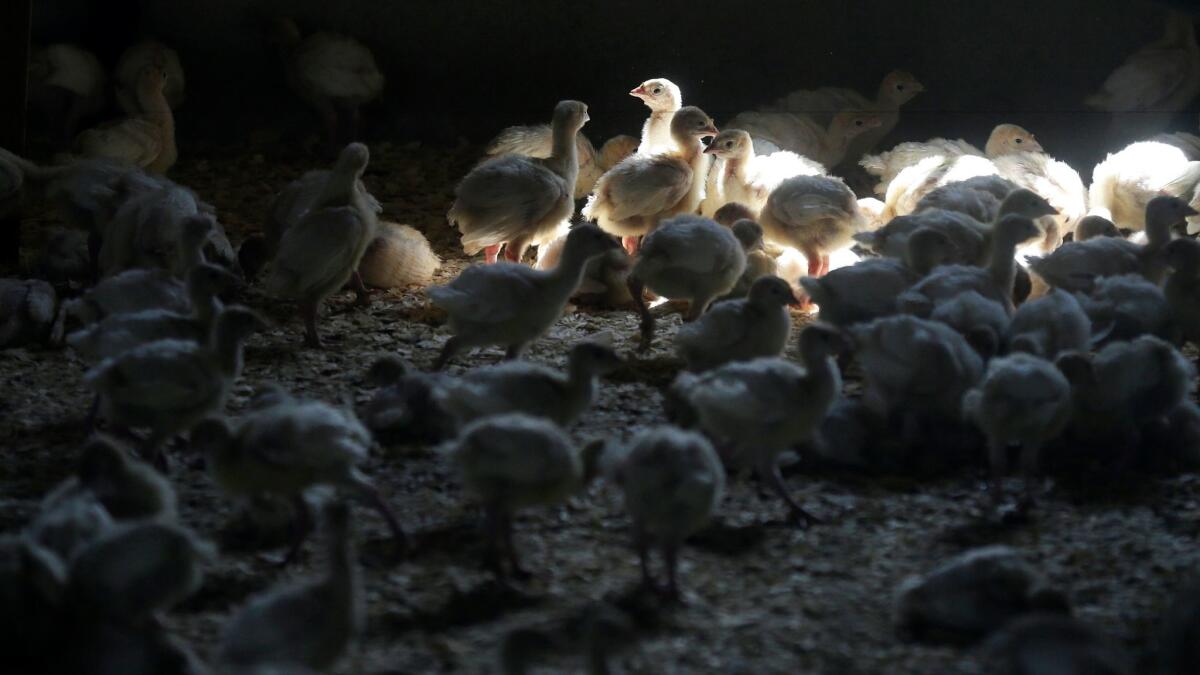Op-Ed: Consider the turkey on Thanksgiving. Specifically, consider not eating it

When I teach practical ethics, I encourage my students to take the arguments we discuss outside the classroom. For Americans, there is no better occasion for a conversation about the ethics of what we eat than Thanksgiving, the holiday at which, more than any other, we come together around a meal.
The traditional centerpiece of the Thanksgiving meal is a turkey, so that is the obvious place to start. According to the National Turkey Federation, about 46 million turkeys are killed for Thanksgiving each year. The vast majority of them — at least 99% — are raised on factory farms. Newly hatched turkeys are raised in incubators and then debeaked before having their talons cut off. Male turkeys also have their snood removed — the fleshy erectile protuberance that grows from the forehead. All this is done without anesthetic, despite the pain it clearly causes.
The U.S. Department of Agriculture interprets the Humane Slaughter Act as not applying to birds.
The reason for these mutilations is that the birds are about to be placed in dim, poorly ventilated sheds, where they will live out the rest of their lives crowded together with thousands of other birds. The air reeks of ammonia from the birds’ droppings. In these unnatural and stressful conditions, turkeys will peck or claw at other birds, and cannibalism can occur. The snood is removed because it is often a target for pecking from other birds.
When the birds reach market weight, they are deprived of food and water, rounded up, often in a very rough manner, and transported to slaughter. Each year, hundreds of thousands don’t even make it that far — they die from the stress of the journey. If they do make it, they are still not guaranteed a humane death, because the U.S. Department of Agriculture interprets the Humane Slaughter Act as not applying to birds.
The turkeys Americans eat are not like those found in the wild; they have been altered by breeding designed to enlarge the breast. This process has gone so far that the standard American turkey, the descriptively named Broad Breasted White, is incapable of mating because the male’s big breast gets in the way. Here, I tell my students, is an interesting question to drop into a lull in conversation around the Thanksgiving dinner table. Point to the turkey on the table and ask: If turkeys can’t mate, how was that turkey produced?
Some years ago, my friend Jim Mason decided to see for himself how all the hundreds of millions of sexually disabled turkeys are produced. He saw that Butterball, a large industrial producer of turkeys, was advertising for workers for its artificial insemination crew in Carthage, Mo. No prior experience was required. Jim passed a drug test and was put to work.
His first role was to catch the male turkeys by the legs and hold them upside down so that another worker could masturbate them. When the semen flowed out, the worker used a vacuum pump to collect it in a syringe. This was done with one bird after another until the semen, diluted with an “extender,” filled the syringe, which was then taken to the hen house.
Jim also had a spell working in the hen house. Here is his account:
“You grab a hen by the legs, trying to cross both ‘ankles’ in order to hold her feet and legs with one hand. … [Then] you flop her down, chest first, on the edge of the pit with the tail end sticking up. You put your free hand over the vent and tail and pull the rump and tail feathers upward. At the same time, you pull the hand holding the feet downward, thus ‘breaking’ the hen so that her rear is straight up and her vent open. The inseminator sticks his thumb right under the vent and pushes, which opens it further until the end of the oviduct is exposed. Into this, he inserts a straw of semen connected to the end of a tube from an air compressor and pulls a trigger, releasing a shot of compressed air that blows the semen solution from the straw and into the hen’s oviduct. Then you let go of the hen and she flops away.”
Jim was supposed to “break” one hen every 12 seconds, 300 an hour, for 10 hours a day. It was, he told me, “the hardest, fastest, dirtiest, most disgusting, worst-paid work I have ever done.”
Back to the Thanksgiving table. Now that the family understands how the bird they are eating came into existence, and what kind of a life and death it has had, I suggest to my students that they canvass opinions on whether it is ethical to support this way of treating animals. If the answer is no, then something needs to be changed for next year’s holiday.
People will say that turkey is traditional at Thanksgiving. In fact, it isn’t clear if the pilgrims ate wild turkey at that first Thanksgiving in 1621, but one thing is sure: They didn’t eat a factory-farmed Broad Breasted White.
Peter Singer is professor of bioethics at Princeton University. This essay was adapted from his latest book, “Ethics in the Real World,” published by Princeton University Press.
To read the article in Spanish, click here
Follow the Opinion section on Twitter @latimesopinion and Facebook
MORE FROM OPINION
Lee Harvey Oswald’s little green book shows JFK wasn’t the real target
I had a health crisis in France. I’m here to tell you that ‘socialized medicine’ is terrific
How to build a bridge, shipyard or highway even a conservative could love
More to Read
A cure for the common opinion
Get thought-provoking perspectives with our weekly newsletter.
You may occasionally receive promotional content from the Los Angeles Times.






